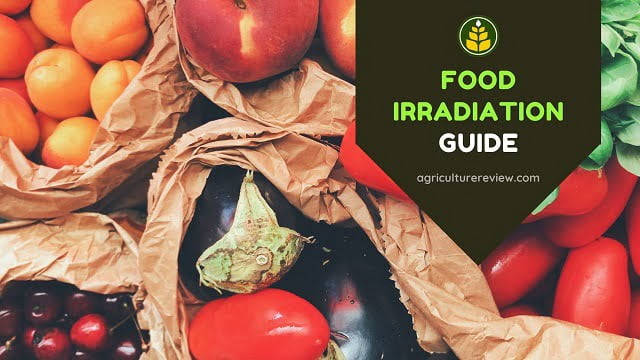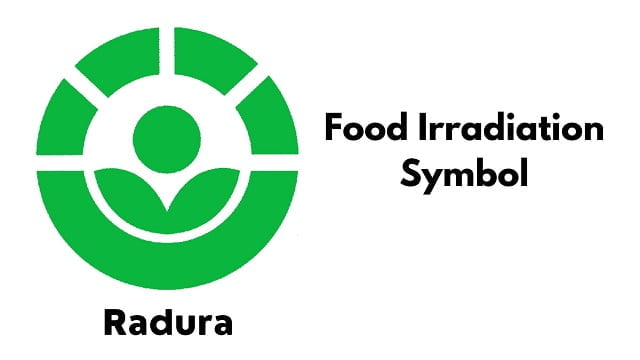This ultimate guide on food irradiation will help you to understand what is irradiation of food, application, pros and cons. It is a necessary part of food processing industries to extend shelf life of the food.
It helps farmers and traders to sell their produce for longer duration and reduce degradation. Hence from the point of food security and economy it is very necessary for everyone to understand the complete process.
Table of Contents
What Is Food Irradiation?
Food irradiation is a preservation and processing technique with similar result to pasteurization. During this procedure food is exposed to dozes of ionizing radiation at low dozes. Irradiation at low dozes extends the shelf life and higher dozes kills the insects, moulds, bacteria, and other harmful organisms.
Application of radiation doze to a food depends on the resistance of microorganisms treated and the objectives of the treatment.
The maximum recommended doze of irradiation of food is 15 kGy( Kilo Grey) and the average doze is not exceeding 10 kGy.
Three sources of radiation are used for food irradiation, UV rays, gamma rays, and electron beam. Radioactive forms of the element Cobalt 60 or Caesium 137 emits gamma rays. Electron beams are produced from an electron accelerator source on the food.
Application
It can be applied for the following purposes:
A) Sterilization,
B) Radicidation (reduction of pathogens),
C) Radurization,
D) Disinfestation,
E) Controlling Ripening,
F) and Inhibition of Sprouting.
Sterilization (Radapperization)
It Refers to the sterilization with the help of radiation to the extent of destroying all forms of microorganisms. Used to sterilize meat, herbs and spices. Although it is technically possible to sterilize meat and other products but the dose required exceeds the current limit of 10 kGy.
A dose of 48 kGy is needed for reduction of Clostridium botulinum, but such high dose would make the product such as meat organoleptically unacceptable. Herbs and spices are the most preferred products to be sterilized using a dose of 8- 10 kGy which reduces microbial load to an acceptable level without loss of volatile oil.
Reduction Of Pathogens (Radicidation)
It has become one of the most important application of food irradiation due to increasing incidence of food poisoning. Irradiation of 5 kGy or below are effective in destroying non spore forming pathogens.
Fresh poultry ( full of Salmonella species) can be irradiated with a dose of 2.5 kGy, this doubles its shelf life when the product is kept below 5 ֯C. higher doses of 10 kGy are applied to frozen poultry to destroy E. coli or Vibrio cholerae.
Prolonging Shelf Life (Radurization)
Very low levels of radiations are needed to improve the keeping quality of a food by destroying the yeast, moulds and non- spore forming bacteria. This increase the shelf life by an overall reduction in vegetative cells.
Bacteria which survive irradiation are more susceptible to heat treatment and the combination of irradiation with heating is beneficial in causing a greater reduction in microbial number than would be achieved by either treatment alone.
Control Of Ripening
Some types of fruits and vegetables such as strawberry and tomatoes can be irradiated to extend their shelf life about 2-3 times when stored at 10֯C . A combination of irradiation and modified atmosphere packaging has shown a good effect and as a result, to achieve the same result one can use lower doze of radiation.
But these products should be ripe before irradiation as ripening process is inhibited. A two fold increase in the shelf life of mushroom and inhibition of cap opening can be achieved by doses of 2-3 kGy.
Disinfestation
Grains and tropical fruits may be infested with insects and larvae which lower their export potential and require a quarantine period for disinfestation.
Low doses of 1 kGy are effective for disinfestation and also extends the shelf life by delaying ripening. This avoids the use of pesticides such as methyl bromide that are responsible for depleting the ozone layer.
Inhibition Of Sprouting
This technology is effective on inhibiting the sprouting of potatoes for their further processing. Dose of 0.06- 0.20 kGy inhibit sprouting in potatoes, onion ,garlic ginger and chestnut etc.
Irradiated Food With Dosage Limits
| Application | Dosage | Food Example |
|---|---|---|
| Sterilization | 7-10 kGy | Spices and Herbs |
| Sterilization Of Packing Material | 10-25 kGy | Wine Corks |
| Inhibition Of Sprouting | 0.1-2 kGy | Onions, Potatoes, Garlic |
| Inhibition Of Ripening | Till 1 kGy | Fruits |
| Inactivation Of Parasites | 0.1-6 kGy | Pork |
| Destruction Of Pathogens | 2.5-10 kGy | Frozen Meat, Spices, Shrimp |
| Disinfestation | 0.1-2 kGy | Grain Flour, Dry foods, Fruits |
| Extension Of Shelf Life | 2-5 kGy | Fruits, Fish, Soft Drinks |
Food Irradiation Process

Food is first packed in containers and then it is taken to shielded room with the help of conveyer belt. Then food is exposed to radiant energy source inside shielded room. The amount of radiation can vary according to the type of food.
The radiant waves passes through the food, where it breaks molecular structure of DNA of harmful micro-organisms. Due to radiation these organisms either die or become unable to reproduce. The food is then taken out from the shielded room.
You will also love reading them,
READ MORE: Food Definition and Classification
READ MORE: Kiwi Farming Guide
Is Food Irradiation Safe?
Considerable scientific research over the five decades indicates that food this process of food preservation is safe and effective. It provides an additional protection to food without significant change in taste, nutritional value, colour or texture.
Concerns addressed by joint FAO and WHO, Expert committee on wholesomeness of irradiated food concluded that average doze of 10 kGy does no toxicological hazard, no special nutritional and microbial problems in food.
However they also advised that irradiated food should be labelled. Because irradiated food should not be irradiated again as it can harm the food molecular and biological structure.
FDA has approved following foods that are safe for irradiation:
- Fresh Fruits
- Fresh Vegetables
- Poultry
- Crustaceans
- Pork
- Shellfish
- Spices and Seasonings
- Seeds for sprouting.
Food Irradiation Symbol
FDA currently stated that irradiated food should show the international symbol for irradiation called “Radura.” Furthermore it should also be labelled with a statement such as ‘treated with radiation’ or treated by radiation.’

Disadvantages
Radiation could adversely affect the nutritional quality of food. High energy radiation can break down the nutrients that destroys Vitamins and Minerals.
Radiation in irradiation processing units can be harmful for workers. Radiation can cause adverse effects on environment and ground water pollution.
Due to radiation, resistance in microorganism develops.
Radiation destroys spoiling bacteria but pathogenic bacteria are not destroyed completely.
Toxins producing bacteria are destroyed after they have contaminated the food.





